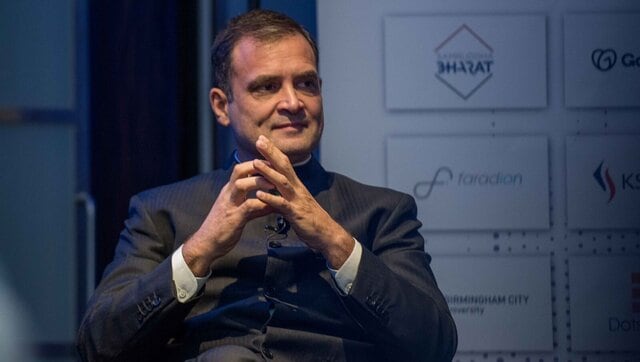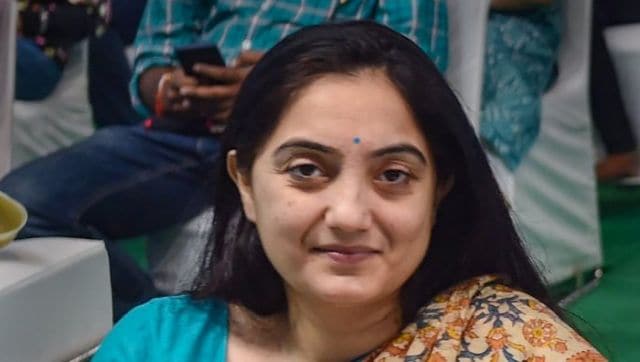During his recent visit to London, Rahul Gandhi made a rather incendiary remark. “BJP has spread kerosene all over the country, one spark can put us in big trouble,” he said in the course of an interaction. The ominous developments of the last few weeks has made some people wonder if Gandhi was prescient or he had some prior knowledge that others were not privy to. With violent street protests becoming the norm rather than the exception, some people have expressed genuine fears about the nation slipping into anarchy. Though India has a tradition of non-violence, not all protests are peaceful. Conflict experts have opined that protests with a limited amount of violence are part of the democratic process. If not allowed, it could lead to rebellion, which may be further detrimental to society. Thus India too had its fair share of violent protests over the years. [caption id=“attachment_10701671” align=“alignnone” width=“640”]  Congress leader Rahul Gandhi at the Ideas for India conference in London on 20 May. Twitter/ @RahulGandhi[/caption] However, the frequency and intensity of such agitations have visibly increased in the last couple of years. The anti-Citizenship (Amendment) Act demonstrations at Delhi’s Shaheen Bagh in late 2019 was a turning point of sorts. It gained momentum with the 2020-21 Kisan Andolan (Farmers’ agitation) against new farm laws — choking the borders of the National Capital Region for nearly a year and a half culminating in some gruesome incidents. The heat has been on since then with frequent sporadic outburst across the country. After some clashes between members of two communities on Ram Navami and Hanuman Jayanti, the major flashpoint was the alleged blasphemous remarks of a Bharatiya Janata Party spokesperson on national TV about Prophet Mohammed. This triggered serious riot-like situations at many places but most notably in Uttar Pradesh. Serious riot-like situations broke out in the two major cities of Kanpur and Prayagraj (formerly Allahabad) that invited strong retaliation from the Yogi Adityanath government. One would have expected the opposition to jump into the fray — if only to fish in troubled waters as has been their wont. However, other than Muslim parties like the AIMIM (All India Majlis-E-Ittehadul Muslimeen) and some muted comments from Akhilesh Yadav of the Samajwadi Party, others chose to maintain a studied silence. However, what took everyone by surprise at this juncture was the mobilisation of Congress workers in Delhi and several other state capitals for holding ostensible “Satyagraha” against the summons issued to its leader Rahul Gandhi by the Enforcement Directorate on an old case of alleged tax-evasion and money laundering. What would have otherwise been a matter of routine investigation and legal proceedings was magnified into a political war against the government by the principal Opposition party — viz the Congress — which accused the BJP of pursuing a political vendetta against its first family. Streets of Delhi were converted into virtual battlegrounds under the full glare of TV cameras, ripples of which were felt in other parts of the country as well. The Modi government went about its business as usual through this drama. Narendra Modi carried on with his normal schedule that included a two-day visit to Maharashtra and then to Himachal Pradesh. In the midst of all this, the Modi government made two major announcements on the employment front tacitly acknowledging that there was a problem in job creation in the post-Covid economic downturn. The first among these was the plan for opening up hiring in the Central government with a target of filling one million vacancies in the next eighteen months on a mission mode. The second was an innovative, even if slightly radical, programme of a short-service “tour of duty” named “Agnipath” for youth between the age of seventeen to 21. As has become customary both these moves were received with a large dose of cynicism and hefty criticism by the Opposition. The Agnipath proposal drew sharp reactions from some sections of civil society, defence experts, retired armed forces officers and former civil servants. Debates are healthy in any system. So there was no problem till there. But everyone was taken aback when violent protests broke out at several places in Bihar allegedly by armed force aspirants. There were horrific scenes of arson with the protestors setting fire on trains and destroying public property. Some misunderstanding could have arisen from incomplete and unclear communication but the speed and vengeance with which it was played out raises several questions. But more disturbing is the perception of a pattern that seems to be emerging from the series of events. The easiest way to explain the growing phenomenon would be by building a conspiracy theory and blaming the ubiquitous but invisible “foreign hand” that the late prime minister Indira Gandhi frequently alluded to. This ties in well with the lighting a match to “kerosene” comment cited earlier as talks of attempts for a regime change has been in the air for long. Secessionist forces have been at work for long and they are known to have spread tentacles across the country. The threat of Islamic terror is real with organisations like the Islamic State, Lashkar-e-Taiba and Al Qaeda operating by proxy or through sleeper cells. But laying the problem at the door-steps of outsiders would be a lazy option and a more in depth analysis is called for. Indira’s grandson, Rahul Gandhi and the Left liberal fraternity has always alleged that the BJP follows a divisive strategy creating deep fault lines between communities, castes and regions — steamrolling the pluralistic idea of India. There is a concerted chorus of voices that are trying to portray India as a place where religious minorities are under threat, Human Rights are being steam-rolled and press-freedom throttled. A Hindu Right-wing government is turning the country into a fascist police state is their cry.
***
Also Read **National Herald case: Rahul Gandhi, his mother and the Al Capone moment** **National Herald case: Rahul Gandhi questioned by ED for over eight hours, summoned again tomorrow** Explained: National Herald, the Gandhi connection, and the money laundering case **Prophet Muhammad row: How support for Nupur Sharma is growing each day** **How Nupur Sharma saga raises more questions than it answers** **Friday fury! It is not Nupur Sharma issue, it is the mindset** **‘Determined to support’: Dutch politician Geert Wilders on receiving death threats for supporting Nupur Sharma** **Agnipath scheme: A path-breaking, futuristic initiative that should be welcomed** **Agnipath scheme: Checkmate the false narrative as it’s a game-changer for India and the defence forces** **Agnipath scheme has its reasons, but government should have initiated it as a pilot project** **How's the josh? Why Centre's new Agnipath recruitment programme for soldiers is considered revolutionary** **Education ministry to recognise in-service training received by 'Agniveers' as credits for graduation**
***
Some commentators have said the root of the problem does not lie in religion but lack of jobs. They may have a point. Even Narendra Modi has always maintained that the answer to all religious and social tensions is economic development. But alas, that takes time and if derailed by unforeseen developments like the pandemic or a war it can easily derail the best of plans. Although poverty and unemployment are often the root cause of crime and violence, empirical evidence does not show that it is always the case. Many supporters of Narendra Modi feel that although he is a communicator par excellence, his government as whole lacks the understanding of how to reach the message to the last mile. It has an unhealthy level of dependence on the “Modi Magic”, belief in welfare schemes as a panacea and the unshakeable faith in its committed cadre to deliver in the hustings. With the result a degree of arrogance may have set in that cuts communication channels forcing people to hit the streets for being seen to be heard. To their credit, however, they have achieved some element of success by this strategy with the government rolling back the farm laws and putting the implementation of CAA on hold. The hurried expulsion of Nupur Sharma — the BJP spokesperson accused of blasphemy — is cited as another case of throwing its own people under the bus yielding to international pressure. [caption id=“attachment_10763831” align=“alignnone” width=“640”]  BJP spokesperson Nupur Sharma was suspended for her controversial comments on Prophet Muhammad, which has outraged Islamic nations. PTI[/caption] Even on Agnipath the defence minister has already announced some amendments which people are viewing as a direct impact of the Bihar agitations. Opposition leader Priyanka Gandhi has already sensed that the government is on the backfoot and demanded a complete roll back of the scheme. Rent-a-cause activists like Rakesh Tikait of the kisan movement are ready to jump in as well. BJP and Modi loyalists feel the government capitulated too early which has further emboldened its detractors. They, therefore, advocate a muscular, nay “bull-dozer” approach in tackling subversive forces. [caption id=“attachment_10798581” align=“alignnone” width=“640”]  Defence Minister Rajnath Singh. ANI[/caption] The truth as always lies somewhere in between. It could well be a combination of factors that are causing these repeated impasses and imbroglio. Whatever it may be, PM Modi and his core team may need to do some serious “chintan” on how to neutralise the disruptive forces — which if not contained can seriously impede the effectiveness of the government in the remaining months of its second term — which also coincides with the highly inspirational “Azadi ka Amrit Kal”. The author is a current affairs commentator, marketer, blogger and leadership coach, who tweets at @SandipGhose. Views expressed are personal. Read all the Latest News , Trending News , Cricket News , Bollywood News , India News and Entertainment News here. Follow us on Facebook, Twitter and Instagram.


)
)
)
)
)
)
)
)
)



